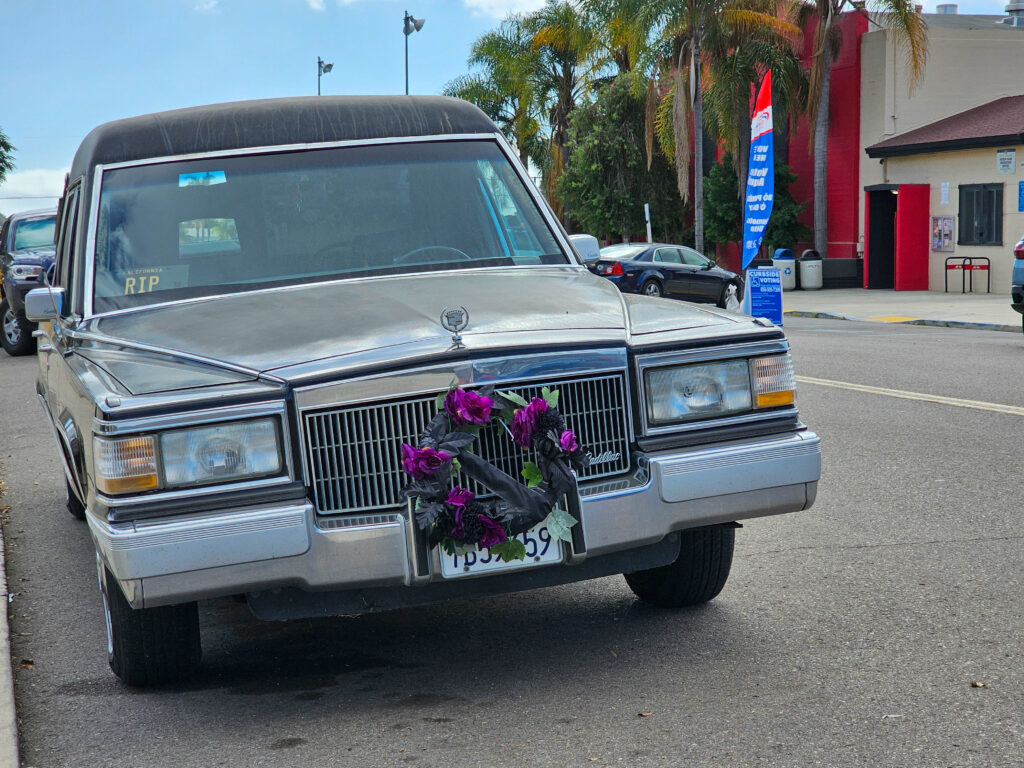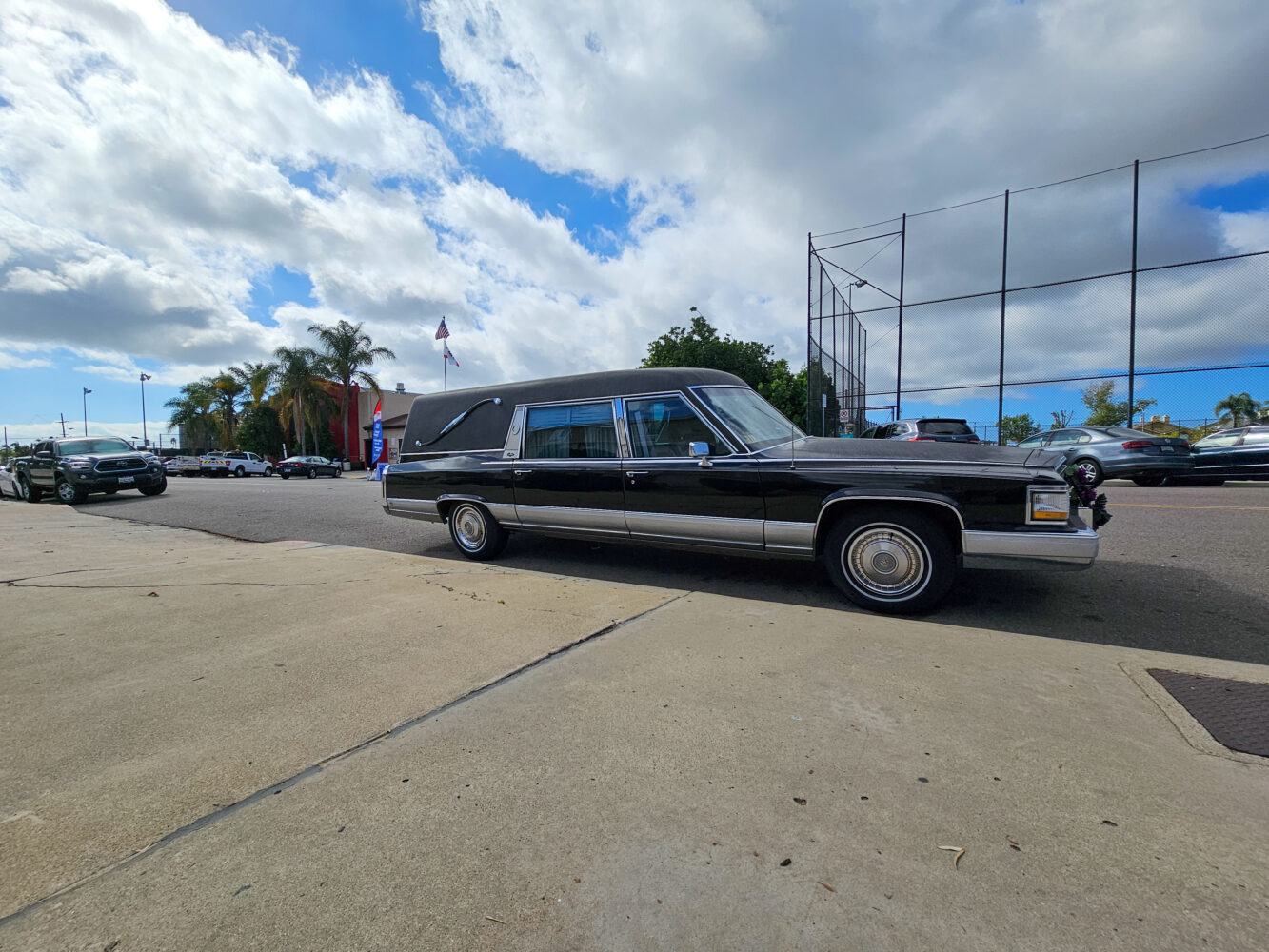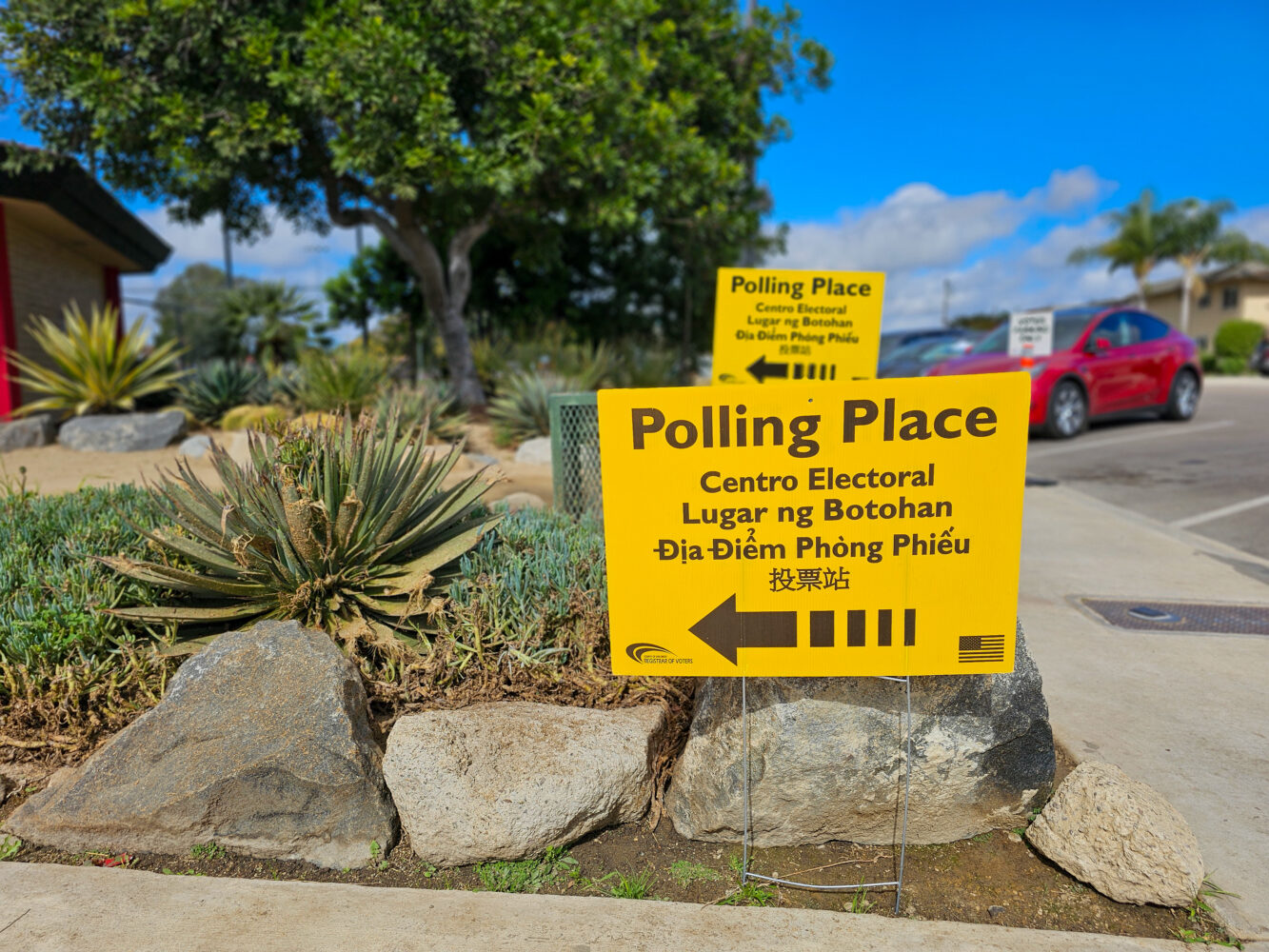Foreshadowing is a common storytelling technique. Perhaps in a movie with what I call a “French ending”, the handsome hero stubs his toe early on, only to later die of blood infection. A different kind cuts across genres: In the classic trope from American cinema, a sidekick is introduced with intriguing backstory and quickly developed character, which signals that his or her death is imminent.
My question: What does a hearse parked across from the polling place in North Park foreshadow? The death of our constitutional republic? Or of democracy, if you prefer? Judging by the advanced ages of the people choosing to vote in person, on-call ambulance wouldn’t be unreasonable precaution. Hearse is a bit much, but, hey, surely someone will croak while voting somewhere. “Be prepared” is the Boy Scot motto and that of undertakers everywhere.
No Longer Golden
Maybe I miss something subtler: Pushed over the dashboard against the windshield was a vanity plate that essentially reads “California RIP”. For sure, cost of living is killing the Golden State, from which people are fleeing. California’s population declined by 800,000 between January 2020 and 2023. Public Policy Institute of California tallies the reasons, observing that “a significant driver of the state’s population loss has been residents moving to other states—most often Texas, Oregon, Nevada, and Arizona. Housing costs loom large in this dynamic”.
Cost of living, crime, drug overdoses, homelessness, progressive policies, and small business regulations are among the reasons residents—or corporations—might move out. But I digress. The hearse was parked across from the poll, which demands metaphor about death and democracy.
Slim Margins
As I explained in Jan. 20, 2021 analysis “Divided We Stand“, the presidential election came down to 42,844 votes spread across three states: Arizona, Georgia, and Wisconsin. Two of those states struggled to tally ballots, too, reporting them late. The numbers have changed somewhat since, with current total 42,945. Precisely:
- Joseph Biden’s margin of victory in Arizona was +0.31, or 10,457 votes out of 3,387,326 cast. Electoral value: 11.
- Biden’s margin of victory in Georgia was +0.24, or 11,776 votes out of 4,999,960 cast. Electoral value: 16.
- Biden’s margin of victory in Wisconsin was +0.62, or 20,682 votes out of 3,297,352 cast Electoral value: 10.
Out of 155,506,996 million votes nationally, 42,945 determined the election’s outcome. Take those three states away from Biden, and each candidate would have had 269 electoral votes, and neither one able to reach 270 to win. In that circumstance, the Constitution’s solution is this: The House of Representatives chooses the President and the Senate picks the Vice President. Republicans had more votes to cast than Democrats in both Houses, almost assuring Donald Trump and Michael Pence another four-years.
False Claims?
Given that 2020 was the first election with nearly national mail-in ballots, one consistent accounting and authentication standard should have been used in all jurisdictions of the same state. Should imperfect ballots—say, missing date or signature—be counted? I say no. Should voter rolls be purged of people who have died or moved away? I say yes. But we know that ballots were cured during tallying and votes were counted from people ineligible to vote.
The math doesn’t lie and explains the rationale behind Trump’s position about the election results. You needn’t massive fraud or compromised voting machines—as the conspiracy wonks assert—to turn Biden’s victory to a tie that he loses.
My profession, journalism, is supposed to act in the public interest. Too many of my fellow reporters wanted Trump to lose and thus failed to even consider investigating. Someone coined “false claims” three years ago, and the phrasal accusation has reverberated since. But the narrow margin of victory as measured by how our republic determines winners—electoral count—demanded immediate investigation by federal or state attorneys general and the mass news media. That’s not an outcome they wanted, so they adopted the three-monkeys’ rule: See no evil. Hear no evil. Speak evil.
Undertaking Democracy
I am opposed to massive mail-in ballots, and many other countries conducting fair elections agree. In an op-ed leading up to Election 2020, John R. Lott, Jr., president of the Crime Prevention Research Center, asserted: “If concern about voter fraud with mail-in ballots is delusional, it is a delusion that is shared by most of the world. Even the countries that allow mail-in ballots have protections, such as government-issued photo IDs”. For example:
Among the 27 countries in the European Union, 63 percent ban mail-in voting unless living abroad and another 22 percent require a photo ID to obtain a mail-in ballot. Twenty-two percent ban the practice even for those who live abroad. There are 16 countries in the rest of Europe, and they are even more restrictive. Every single one bans mail-in voting for those living in the country or require a photo ID to obtain a mail-in ballot. Sixty-three percent don’t allow mail-in ballots even for citizens living outside of the country.
When my wife and I went to the poll today, we deliberately left home our mail-in ballots to see what would happen. We filled out quick questionnaire, sat with someone inputting the information onto an iPad, and electronically processing our ballot to be filled in on a terminal and then printed. Neither of us was asked for proof of identification. Anyone could have pretended to be us or we someone else.
Think of all the places where you must present identification. But not to vote?
In California, now, all registered voters receive mail-in ballots. Expectation is they will be posted or dropped in county-approved collected boxes, which can be stuffed by ballots that third parties collect or otherwise interfered with. Walter Olson of the Cato Institute explains some of the potential abuses:
Consider the dangers of ballot tampering. Contrary to some imaginings, the abuse that is probably likeliest is not that the collector will switch the choice of party at the top of the ticket. Far harder to police is the practice of ‘helping’ unsophisticated voters by filling in choices for down‐ballot races that they might have left blank on their own.
Gaudier abuses, such as the collection of pseudo‐ballots from voters who are dead, never intended to vote, or never existed at all, are not unthinkable—politicos are capable of thinking of anything.
If we don’t undertake democracy, the undertaker may come for our republic—dead before its time. Then during a future election, the people going to the polls will be little more than a funeral procession. That’s the metaphor of the hearse and what it foreshadows.
Okay, let’s talk Featured Image and companion, which aren’t what I had hoped. There simply wasn’t enough signage outside the polling place to stand out across the street where the vehicle was parked. I used Samsung Galaxy S23 Ultra for both. Vitals, first: f/2.4, ISO 50, 1/1800 sec, 70mm (film equivalent); 11:53 a.m. PST. Second: f/2.2, ISO 50, 1/5800 sec, 13mm (film equivalent); 11:54 a.m. Third: f/1.7, ISO 10, 1/1000 sec, 23mm (film equivalent); 11:51 a.m.


